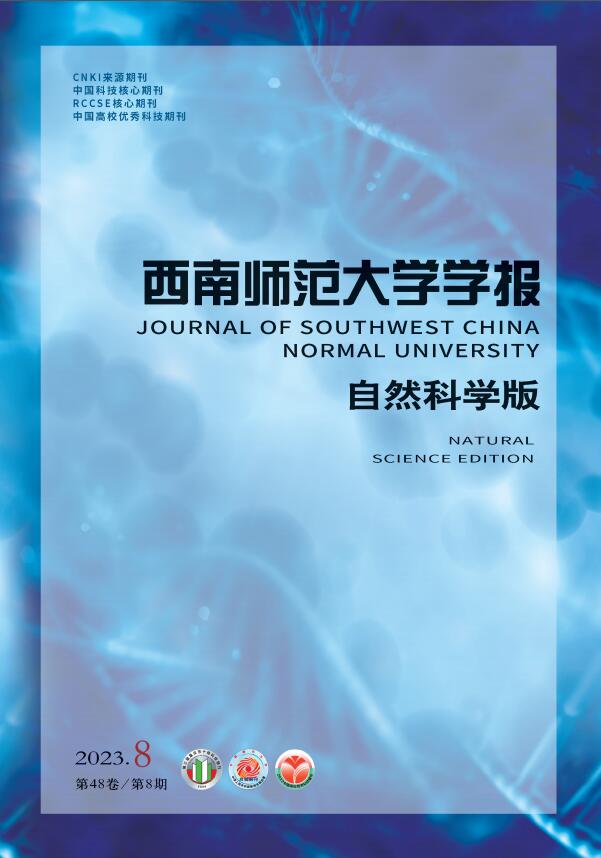-
矩阵的特征值问题是求取一个矩阵的特征值和特征向量. 文献[1]对矩阵的特征值、特征向量以及特征对进行了定义. 文献[2]提出了特征值问题的高精度数值算法. 文献[3]定义了矩阵的最小特征值. 从一组规定的特征数据重构特殊结构的矩阵的问题统称为逆特征值问题. 逆特征值问题的难度等级取决于要重构的矩阵的结构以及可用的特征信息的类型. 文献[4]详细描述了各种逆特征值问题. 文献[5]研究了一些特殊类型(如对角矩阵、Jacobi矩阵和箭形矩阵)的逆特征值问题. 文献[6-9]研究了一些由特殊图描述构建的矩阵的逆特征值问题, 特别地, 文献[6-7]研究了图为路的非循环矩阵和图为扫帚的矩阵. 文献[10-13]研究了机械振动、控制理论、极点分配和图论等各种领域中矩阵的逆特征值问题. 文献[10]从力学角度详细阐述了振动中的一些逆特征值问题, 其中弹簧质量系统等振动结构参数识别问题往往可以归结为Jacobi矩阵的逆特征值问题, 星形弹簧质量系统的振动问题则归结为箭形矩阵的逆特征值问题. 文献[14-16]分别研究了箭形矩阵、Jacobi矩阵以及由箭形矩阵和Jacobi矩阵构成的特殊矩阵的逆特征值问题.
HTML
-
文献[9]研究了图为路的矩阵和图为扫帚的矩阵, 其中图为路Pn的矩阵An是对角线为非零元素的三对角矩阵, 图为扫帚Bn+m的矩阵An+m是三对角矩阵和箭形矩阵的组合, 矩阵An和An+m形式分别为
因此, 可推广出如图 2所示的矩阵A.
矩阵A的形式为
其中, ai(i=2, …, m, m+2, …, m+n)互不相同, bi(i=1, …, m+n-1)不为0, 且bm>0, 当m=0或n=0时, 形如(1)式的矩阵A为箭形矩阵, Am, m+2为Jacobi矩阵.
特殊矩阵A的两类逆问题为:
问题1 给出3个非零互异实数λ1, λ2, μ, 3个非零实向量x1=(x1, …, xm)T, x2=(xm, …, xm+n)T, y=(y1, …, ym+n)T. 求具有形如(1)式的m+n阶矩阵A使得(λ1, x1), (λ2, x2), (μ, y)分别是A1, m, Am, m+n和A的特征对. 其中A1, m, Am, m+n是A的主子式, 分别有以下形式:
可知A1, m, Am+1, m+n均为箭形矩阵, Am, m+2为Jacobi矩阵.
问题2 给定2m+2n-1个实数λ1(j)(j=1, …, m+n)和λj(j)(j=2, …, m+n), 讨论在什么条件下可以构造出具有形如(1)式的m+n阶矩阵A, 使得λ1(j)和λj(j)分别为Aj(j=1, …, m+n)的最小、最大特征值.
-
现作如下约定:
引理1 对给定的具有形如(1)式的矩阵A, 其特征多项式序列{Pj(λ)=det(λIj-Aj)}j=1m+n满足下列递推关系:
其中, P0(λ)=1, b0=0.
引理2[16] 若ai(i=2, …, m)互不相同, Aj(j=1, 2, …, m)的特征值为λ1(j)≤λ2(j)≤…≤λj(j), 则λi(j)(i=1, 2, …, j)为互不相同的实数, 且λ1(j) < a2 < λ2(j) < … < λj-1(j) < aj < λj(j).
引理3[16] 若ai(i=2, 3, …, m)互不相同, 则相邻的两个特征多项式Pj-1(λ), Pj(λ)(j=1, 2, …, n)不能同时为0.
引理4[16] 设Aj-1的特征值为λ1(j-1), λ2(j-1), …, λj-1(j-1), Aj的特征值为λ1(j), λ2(j), …, λj(j), 则λ1(j) < λ1(j-1) < λ2(j) < λ2(j-1) < … < λj-1(j) < λj-1(j-1) < λj(j), 即Aj-1的特征值与Aj的特征值是严格隔离的.
引理5[6] 对j=1, 2, …, m+n, 若λ1(j), λj(j)分别为Aj的最小、最大特征值, 则:
(ⅰ) 若μ < λ1(j), 则(-1)jPj(μ)>0;
(ⅱ) 若μ>λj(j), 则Pj(μ)>0.
-
定理1 问题1有唯一解的充分必要条件是:
(ⅰ)
$\begin{cases}E_{i} \neq 0 & i=2, \cdots, m-1 \\ M_{i} \neq 0 & i=m+2, \cdots, m+n; \\ \omega \neq 0\end{cases}$ (ⅱ)
$\left\{\begin{array}{l}\left(\lambda_{1}-\mu\right) \sum\limits_{i=1}^{m} x_{i} y_{i}+b_{m} x_{m} y_{m+1}=0 \\ \left(\lambda_{2}-\mu\right) \sum\limits_{i=m+1}^{m+n-1} x_{i+1} y_{i+1}+b_{m-1} x_{m} y_{1}=0\end{array} \right.$ ;(ⅲ)
$b_{m}=\frac{\left[-\left(\lambda_{1}-\lambda_{2}\right) x_{m} y_{1}+\left(\mu-\lambda_{2}\right) x_{1} y_{m}\right] x_{m}}{\omega}>0$ .证 充分性 因为(λ1, x1), (λ2, x2), (μ, y)分别是A1, m, Am, m+n和A的特征对, 所以有
当i=2, …, m-1时, 由A1, mx1=λ1x1, Ay=μy得线性方程组
由条件(ⅰ)Ei≠0(i=2, …, m-1)知ai, bi-1有唯一解:
下证(5)式中ai的两个表达式等价. 由bi-1的表达式得
所以(5)式中ai的两个表达式等价得证.
当i=m时, 由A1, mx1=λ1x1, Ay=μy, Am, m+nx2=λ2x2解得
其中ω=x1xmym+1-x1xm+1ym+xmym+1y1且ω≠0.
当i=1时, 由A1, mx1=λ1x1, Ay=μy解得
下证a1的两个表达式等价. 利用条件(ⅱ)中(λ1-μ)
$\sum\limits_{i=1}^{m}$ xiyi+bmxmym+1=0得即λ1x1y1
$\sum\limits_{i=1}^{m-1}$ bixi+1y1=μy1x1-$\sum\limits_{i=1}^{m-1}$ biyi+1x1, 两边同时除以x1y1, 得证a1的两个表达式等价.当i=m+2, …, m+n时, 由Am, m+nx2=λ2x2, Ay=μy解得
其中Mi≠0. 此处ai的两个表达式等价证明同(5)式.
当i=m+1时, 由Am, m+nx2=λ2x2, Ay=μy解得
下证am+1的两个表达式等价. 利用条件(ⅱ)中(λ2-μ)
$\sum\limits_{i=m+1}^{m+n-1}$ xi+1yi+1+bm-1xmy1=0得则有
即λ2xm+1-bmxm-
$\sum\limits_{i=m+1}^{m+n-1}$ bixi+1=μym+1-bmym-$\sum\limits_{i=m+1}^{m+n-1}$ biyi+1, 两边同时除以xm+1ym+1, am+1, 表达式等价得证.由条件(ⅰ)和(ⅱ)可知, ai, bi-1是问题1的唯一解, 且给出解的表达式(5), (6), (7), (8), (9), 充分性得证.
必要性 若问题1有唯一解, 则线性方程组(4)有唯一解, 则可推出条件(ⅰ)成立. 又因矩阵A的顺序主子式Am, m+2为Jacobi矩阵, 若问题1有解, 则条件(ⅲ)成立. 下证条件(ⅱ)成立.
若问题1有解, 则要满足A1, mx1=λ1x1, Ay=μy, 通过计算得(λ1-μ)
$\sum\limits_{i=1}^{m}$ xiyi=-bmxmym+1, 条件(ⅱ)中(λ1-μ)$\sum\limits_{i=1}^{m}$ xiyi+bmxmym+1=0得证.若问题1有解还需同时满足Am, nx2=λ2x2, Ay=μy, 同理可证条件(ⅱ)中(λ2-μ)
$\sum\limits_{i=m+1}^{m+n-1}$ xi+1yi+1+bm-1xmy1=0.因此必要性得证. -
定理2 给定2n+2m-1个实数λ1(j)(j=1, 2, …, m+n)和λj(j)(j=2, …, m+n), 存在唯一的A, 使得λ1(j)和λj(j)分别为Aj(j=1, …, m+n)的最小、最大特征值的充分必要条件为:
证 充分性 每个对角元素ai也是A的1×1主子矩阵, 因此λ1(j)≤ai≤λj(j)(1≤i≤j), 所以λ1(j)和λj(j)分别是Aj的最小、最大特征值, 则问题2有解等价于求解Pj(λ1(j))=0, Pj(λj(j))=0, 存在解aj, bj-12, 且bj-12>0(j=1, 2, …, m+n). 下面用引理1的递推关系解决该问题.
当j=1时, P1(λ1(1))=0, 即λ1(1)-a1=0, 则有a1=λ1(1).
当j=2时, 由P2(λ1(2))=0, P2(λ2(2))=0得
令D2表示此方程组中a2和b12的系数矩阵的行列式, 则D2=P1(λ1(2))-P1(λ2(2)), 因此得
当j=3, …, m时, 由Pj(λ1(j))=0, Pj(λj(j))=0得aj和bj-12的线性方程组为
Dj=Pj-1(λ1(j))
$\prod\limits_{i=2}^{j-1}$ (λj(j)-ai)-Pj-1(λj(j))$\prod\limits_{i=2}^{j-1}$ (λ1(j)-ai), 由引理5知(-1)j-1Pj-1(λ1(j))>0, Pj-1(λj(j))>0.由引理2知
$\prod\limits_{i=2}^{j-1}$ (λj(j)-ai)>0, (-1)j-2$\prod\limits_{i=2}^{j-1}$ (λ1(j)-ai)>0, 故(-1)j-1Dj>0, 则方程(11)存在唯一解aj, bj-12, 且当j=m+1和j=m+2时, 由Pj(λ1(j))=0, Pj(λj(j))=0得aj和bj-12的线性方程组为
mj=Pj-1(λ1(j))Pj-2(λj(j))-Pj-1(λj(j))Pj-2(λ1(j)), 由引理5得(-1)j-1mj>0, 则方程(13)存在唯一解aj, bj-12, 且
当j=3, …, n时, λ1m+j和λm+jm+j分别为Am+j的最小、最大特征值, 则Pm+j(λ1m+j)=0, Pm+j(λm+jm+j)=0, 即
由柯西交错定理得
因此
$\prod\limits_{i=2}^{j-1}$ (λm+j(m+j)-am+i)≥0且(-1)j-1$\prod\limits_{i=2}^{j-1}$ (λ1(m+j)-am+i)≥0, 则由引理5得(-1)m+j-1Dm+j≥0(j=3, …, n), 因此若使Dm+j=0, 则有(-1)m+j-1Dm+j=0, 即
下面对(17)式进行讨论. 若Pm(λ1(m+j))=0, 因为λ1(m+j)≤λ1(m+j-1)≤…≤λ1(m), 且λ1(m)是Pm=0时的最小特征值, 所以λ1(m+j)=λ1(m+j-1)=…=λ1(m), 则Pm(λ1(m+j))=Pm-1(λ1(m+j))=0, 这与引理3矛盾, 所以Pm(λ1(m+j))≠0, 同理可证Pm(λm+j(m+j))≠0.
若
$\left\{\begin{array}{l}P_{m+j-1}\left(\lambda_{1}^{(m+j)}\right)=0 \\ P_{m+j-1}\left(\lambda_{m+j}^{(m+j)}\right)=0\end{array}\right.$ , 则由bn+j-1≠0和(15)式得$\prod\limits_{i=2}^{j-1}$ (λ1(m+j)-am+i)=0,$\prod\limits_{i=2}^{j-1}$ (λm+j(m+j)-am+i)=0, 即am+i=λ1(m+j), am+i=λm+j(m+j)(i=2, 3, …, n). 而由(16)式得λ1(m+j)=λ1(m+j-1)=…=λ1(m+1), λm+1(m+1)=λm+2(m+2)=…=λm+j(m+j), 因此有Pm+3(λ1(m+3))=0且Pm+2(λ1(m+2))=0, 则有Pm+3(λ1(m+j))=0且Pm+2(λ1(m+j))=0. 由引理1得Pm+3(λ1(m+j))=(λ1(m+j)-am+3)Pm+2(λ1(m+j))-bm+22Pm(λ1(m+j))(λ1(m+j)-am+2). 由Pm+3(λ1(m+j))=0且Pm+2(λ1(m+j))=0得λ1(m+j)=am+2. 同理可得λm+j(m+j)=am+2. 而λ1(m+j)≤am+2≤λm+j(m+j), 所以有λ1(m+j)=λm+j(m+j). 由引理4可知λ1(m+j)=λm+j(m+j)不成立, 因此$\left\{\begin{array}{l}P_{m+j-1}\left(\lambda_{1}^{(m+j)}\right)=0 \\ P_{m+j-1}\left(\lambda_{m+j}^{(m+j)}\right)=0\end{array}\right.$ 不成立. 同理,$\prod\limits_{i=2}^{j-1}$ (λ1(m+j)-am+i)=0且$\prod\limits_{i=2}^{j-1}$ (λm+j(m+j)-am+i)=0也不成立.若
$\left\{\begin{array}{l}P_{m+j-1}\left(\lambda_{1}^{(m+j)}\right)=0 \\ \prod\limits_{i=2}^{j-1}\left(\lambda_{1}^{(m+j)}-a_{m+i}\right)=0\end{array}\right.$ , 则(15)式的系统增广矩阵的秩为1, 因此该系统将有无穷多个解. 同理, 若$\left\{\begin{array}{l}P_{m+j-1}\left(\lambda_{m+j}^{(m+j)}\right)=0 \\ \prod\limits_{i=2}^{j-1}\left(\lambda_{m+j}^{(m+j)}-a_{m+i}\right)=0\end{array}\right.$ , 该系统也会有无穷多个解. 然而, 若加上附加条件λ1(m+j) < λ1(m+j-1)和λm+j-1(m+j-1) < λm+j(m+j)(j=3, …, n), 则有Pm+j-1(λ1(m+j))≠0和Pm+j-1(λm+j(m+j))≠0, 与$\left\{\begin{array}{l}P_{m+j-1}\left(\lambda_{1}^{(m+j)}\right)=0 \\ \prod\limits_{i=2}^{j-1}\left(\lambda_{1}^{(m+j)}-a_{m+i}\right)=0\end{array}\right.$ 和$\left\{\begin{array}{l}P_{m+j-1}\left(\lambda_{m+j}^{(m+j)}\right)=0 \\ \prod\limits_{i=2}^{j-1}\left(\lambda_{m+j}^{(m+j)}-a_{m+i}\right)=0\end{array}\right.$ 不符, 因此$\left\{\begin{array}{l}P_{m+j-1}\left(\lambda_{1}^{(m+j)}\right)=0 \\ \prod\limits_{i=2}^{j-1}\left(\lambda_{1}^{(m+j)}-a_{m+i}\right)=0\end{array}\right.$ 和$\left\{\begin{array}{l}P_{m+j-1}\left(\lambda_{m+j}^{(m+j)}\right)=0 \\ \prod\limits_{i=2}^{j-1}\left(\lambda_{m+j}^{(m+j)}-a_{m+i}\right)=0\end{array}\right.$ 不成立.综上所述, Dm+j≠0当且仅当λ1(m+j) < … < λ1(m+1) < am+i < λm+1(m+1) < … < λm+j(m+j), 即(-1)m+j-1Dm+j>0, 则方程组(15)存在唯一解am+j, bm+j-12(j=3, …, n), 且
必要性 假定存在唯一的m+n阶矩阵A使得λ1(j), λj(j)分别为Aj(j=1, 2, …, m+n)的最小、最大特征值, 由柯西交错定理和引理4得λ1(m+n) < λ1(m+n-1) < … < λ1(2) < λ1(1)<λ2(2) < … < λm+n-1(m+n-1) < λm+n(m+n). 必要性得证.
3.1. 问题1有唯一解的充分必要条件
3.2. 问题2有唯一解的充分必要条件
-
问题1的算法
1. 输入λ1, λ2, μ, x1, x2, y, 以及m, n;
2. 若λ1, λ2, μ, x1, x2, y满足条件(ⅰ)和(ⅱ), 则继续;否则算法结束;
3. 当i=2, …, m-1时, 由(5)式计算ai, bi-1;
4. 当i=m时, 由(6)式计算bm-1, bm, am;
5. 当i=1时, 由(7)式计算a1;
6. 当i=m+2, …, m+n时, 由(8)式计算ai, bi-1;
7. 当i=m+1时, 由(9)式计算am+1;
8. 输出:矩阵A, ai, bi-1.
问题2的算法
1. 输入m, n, 将2m+2n-1个特征值按大小顺序排列;
2. 令a1=λ1(1), 当j=2时, 由(10)式计算a2和b1;
3. 当j=3, …, m时, 由(12)式计算aj和bj-1;
4. 当j=m+1, m+2时, 由(14)式计算aj和bj-1;
5. 当j=3, …, n时, 由(18)式计算am+j和bm+j-1;
6. 输出:矩阵A, aj, bj-1.
-
例1 给定实数λ1=-0.825 7, λ2=-0.596 0, μ=-0.717 2, m=4, n=3, 给定实向量x1=(-0.566 7, 0.096 1, -0.390 3, -0.719 3)T, x2=(-0.719 3, -2.598 9, -0.455 6, -0.267 6)T, y=(0.410 9, -0.075 2, 0.308 0, -0.442 6, 0.122 5, 0.656 8, 0.297 2)T.
根据问题1的算法, 通过MATLAB2017a编程计算ai, bi, 形成矩阵A为
易验证(λ1, x1)是A1, 4的一个特征对, (λ2, x2)是A4, 7的一个特征对, (μ, y)是A的一个特征对, A即为所求.
例2 给定m=4, n=4, 再给出15个实数2.75, 3.9, 4.39, -2.5, 6.1, -4.7, 7.8, -6.64, 10.53, -7.58, 11.8, -8.3, 13, -9.2, 15.7. 将其按以下顺序排列:λ1(8) < λ1(7) < λ1(6) < λ1(5) < λ1(4) < λ1(3) < λ1(2) < λ1(1) < λ2(2) < λ3(3) < λ4(4) < λ5(5) < λ6(6) < λ7(7) < λ8(8), 即-9.2 < -8.3 < -7.58 < -6.64 < -4.7 < -2.5 < 2.75 < 3.9 < 4.39 < 6.1 < 7.8 < 10.53 < 11.8 < 13 < 15.7.
根据问题2的算法, 通过MATLAB2017a编程计算aj, bj-1和am+j, bm+j-1, 形成矩阵A4+4为
重新计算A8的顺序主子阵Aj(j=1, 2, …, 8)的谱Λ(Aj), 得:
以上数据说明问题2的算法是有效的.








 DownLoad:
DownLoad: